About Lakeland

Lakeland, Florida was incorporated January 1, 1885. The town was founded by Abraham Munn, who purchased 80 acres of land in what is now downtown Lakeland in 1882 and platted the land for the town in 1884. Munn was a resident of Louisville, Kentucky.
In 1887, nursery owner Ed Tison claimed to have originated the Marsh Seedless Grapefruit from cuttings on a tree growing on property of J. H. Hancock, north of Lakeland. About the same time he perfected this fruit, he sold his nurseries to C .M. Marsh, who gave his name to the new variety of the citrus family.
In the winter of 1888, H.S. Galloway demonstrated the profitable character of the strawberry crop and its adaptation to this area by netting over $600 from a single acre of strawberries, thus originating the strawberry industry in this county. By 1894 Lakeland was shipping more strawberries than any other place in the state.
The Lakeland Light and Power Company erected a light plant at the corner of Cedar Street and Massachusetts Avenue in 1891. In May of that year plant manager Harry C. Sloan threw the switch which turned on the current, and Lakeland was lighted by electricity for the first time. It was the only town in Florida besides Jacksonville and Tampa to have electric lights.
In the summer of 1898, some 9,000 troops were quartered in Lakeland, awaiting embarkation for Cuba during the Spanish-American War. Regiments camped on Lakes Wire and Morton. Lakeland’s steady growth continued during the early 1900’s. The town’s first bond election in 1901 secured $110,000 for a school building. In that same year Park Trammell, who had been practicing law locally since 1899, was elected mayor. Later he served as governor of Florida and then U. S. senator.
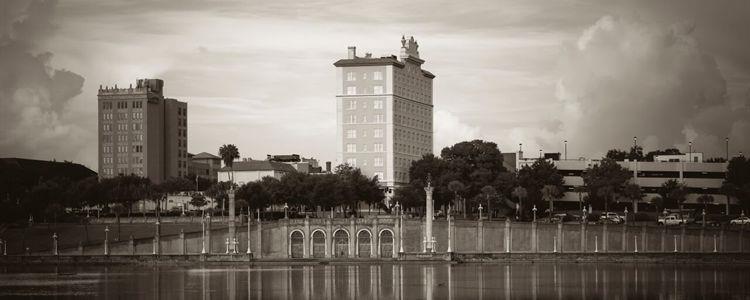
When the Lakeland Terrace Hotel first opened her doors in 1924, she was hailed as one of Florida’s finest new year-round inns, which at the time was a rather novel concept. Prior to that, because air conditioning was not widely used yet, hotels simply opened for “The Season,” and closed for the summer.
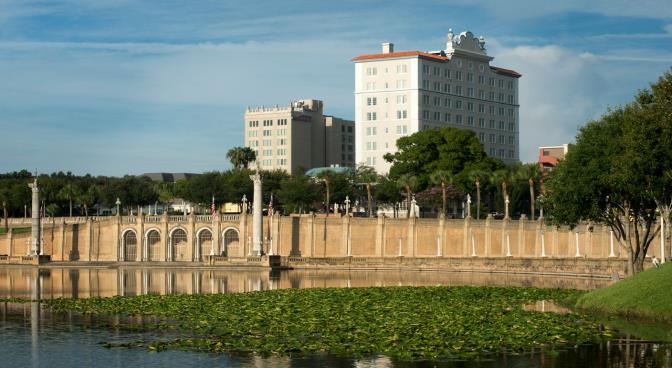
The Florida land boom of the 1920’s resulted in the construction of many significant structures in Lakeland, a number of which are today listed on the National Register of Historic Places. This list includes the Terrace Hotel, New Florida Hotel (Lake Mirror Tower Apartments), Polk Theatre, Park Trammell Building (formerly the Lakeland Public Library and today home to the Lakeland Chamber of Commerce), and others. This was Lakeland’s golden age. The Cleveland Indians held spring training here from 1923 to 1927. The Cleveland Heights subdivision was developed and the Carpenters and Joiners Retirement Home was constructed.
During this same time, two Lakeland residents nearly made aviation history as the first man and woman to fly across the Atlantic. Shortly after Charles Lindbergh crossed the Atlantic, George Haldeman and Ruth Elder attempted to duplicate the feat. Taking off from New York, the couple’s aircraft developed engine trouble a few hundred miles off the coast of Spain and they were forced to ditch in the ocean. They were rescued by a Dutch tanker that took them to Europe, where they were received with much fanfare.
The “boom” period went “bust” quickly, and years passed before the city recovered. Part of the re-emergence was due to the arrival of the Detroit Tigers in 1934 for spring training. The team continues to train here to this day. The development of the Lakeland Municipal Airport as a major facility in central Florida transportation was another factor.
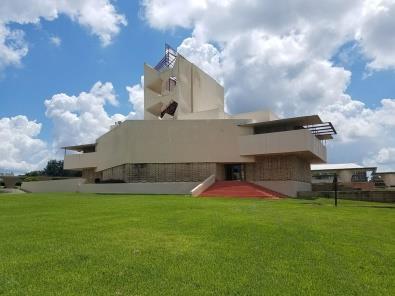
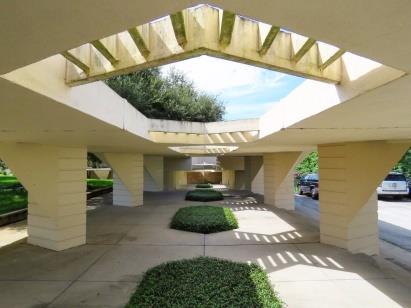
Florida Southern College
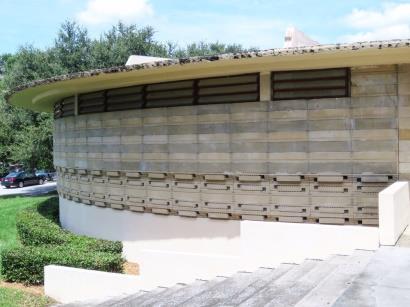
The 1930’s also featured the arrival of renowned architect Frank Lloyd Wright. In 1938 he came to Lakeland at the request of Florida Southern College President Ludd Spivey to design a “great education temple in Florida.” For 20 years Wright worked on his “true American campus” creation. He planned 18 structures, 12 of which were completed and six left on the drawing board. He called his project “A Child of the Sun,” so named from the architect’s own description of being “out of the ground, into the light, a child of the sun.” It is the largest collection of Frank Lloyd Wright designed structures in one location in the world.
The Lodwick School of Aeronautics, owned by aviation pioneer Albert Lodwick, opened in 1940 and trained several thousand men to fly for the U.S. Army Air Corps. At the same time, Food Machinery Company was researching and developing amphibious tanks. Drane Field, in southwest Lakeland, was the site on which B-24 bomber crews trained. The community was solidly behind the war effort.
After the war, George Jenkins rapidly expanded his Publix Supermarket chain and installed his corporate headquarters in Lakeland. The citrus and phosphate industries, though not within the city limits, contributed significantly to Lakeland’s economy. Seventy percent of the phosphate produced in the U.S. was extracted and processed within 25 miles of the city. Citrus growth and production made this area the “World’s Citrus Center.” Through the 1980’s Lakeland and its surroundings produced 25 percent of the nation’s citrus. The Florida Department of Citrus and Florida Citrus Mutual are located here.
